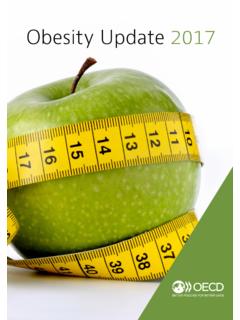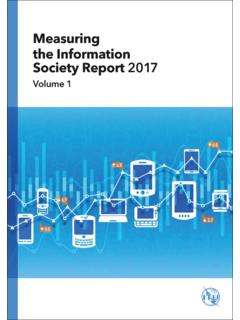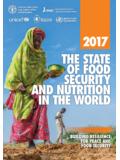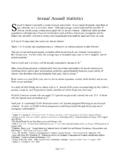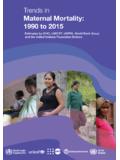Transcription of Cover, contents, executive summary, abbreviations …
1 ISBN 978 92 4 156548 6 world health statistics 2017 : monitoring health for the SDGs, Sustainable Development GoalsISBN 978-92-4-156548-6 world health Organization 2017 Some rights reserved. This work is available under the Creative Commons Attribution-NonCommercial-ShareAlike IGO licence (CC BY-NC-SA IGO; ). Under the terms of this licence, you may copy, redistribute and adapt the work for non-commercial purposes, provided the work is appropriately cited, as indicated below. In any use of this work, there should be no suggestion that WHO endorses any specific organization, products or services. The use of the WHO logo is not permitted. If you adapt the work, then you must license your work under the same or equivalent Creative Commons licence. If you create a translation of this work, you should add the following disclaimer along with the suggested citation: This translation was not created by the world health Organization (WHO).
2 WHO is not responsible for the content or accuracy of this translation. The original English edition shall be the binding and authentic edition .Any mediation relating to disputes arising under the licence shall be conducted in accordance with the mediation rules of the world Intellectual Property citation. world health statistics 2017 : monitoring health for the SDGs, Sustainable Development Goals. Geneva: world health Organization; 2017 . Licence: CC BY-NC-SA (CIP) data. CIP data are available at , rights and licensing. To purchase WHO publications, see To submit requests for commercial use and queries on rights and licensing, see materials. If you wish to reuse material from this work that is attributed to a third party, such as tables, figures or images, it is your responsibility to determine whether permission is needed for that reuse and to obtain permission from the copyright holder.
3 The risk of claims resulting from infringement of any third-party-owned component in the work rests solely with the disclaimers. The designations employed and the presentation of the material in this publication do not imply the expression of any opinion whatsoever on the part of WHO concerning the legal status of any country, territory, city or area or of its authorities, or concerning the delimitation of its frontiers or boundaries. Dotted and dashed lines on maps represent approximate border lines for which there may not yet be full agreement. The mention of specific companies or of certain manufacturers products does not imply that they are endorsed or recommended by WHO in preference to others of a similar nature that are not mentioned. Errors and omissions excepted, the names of proprietary products are distinguished by initial capital reasonable precautions have been taken by WHO to verify the information contained in this publication.
4 However, the published material is being distributed without warranty of any kind, either expressed or implied. The responsibility for the interpretation and use of the material lies with the reader. In no event shall WHO be liable for damages arising from its use. Design and layout by L IV Com S rl, Villars-sous-Yens, by the WHO Document Production Services, Geneva, health statistics 212/05/17 13:16iiiMONITORING health FOR THE SDGsAbbreviations ..vIntroduction ..viPart 1 Six lines of action to promote health in the 2030 Agenda for Sustainable Development ..1 Overview .. Monitoring the health -related SDGs .. health system strengthening for universal health coverage .. health equity leave no one behind .. Sustainable health financing .. Innovation, research and development .. Intersectoral action for ..25 Part 2 Status of the health -related SDGs ..29 Overview .. Reproductive, maternal, newborn and child health .
5 Infectious diseases .. Noncommunicable diseases and mental health .. Injuries and violence .. Universal health coverage and health systems .. Environmental risks .. health risks and disease outbreaks ..33 References ..34 Part 3 Country success stories ..37 Overview .. Ending preventable maternal deaths in Kazakhstan .. Reducing the level of malaria in Papua New Guinea .. Combating viral hepatitis in Cambodia .. Improving health by clearing the air in Ireland .. Preventing suicide in the Republic of Korea .. Preventing early deaths due to alcohol in the Russian Federation .. Fighting the tobacco industry in Uruguay .. Strengthening health emergency preparedness in Monitoring mortality and cause of death in the Islamic Republic of Iran ..47 References ..48 CONTENTSivWORLD health statistics : 2017 Annex A: Summaries of selected health -related SDG indicators ..51 Explanatory notes ..51 Indicator Maternal mortality.
6 52 Indicator Skilled birth attendance ..53 Indicators Child mortality ..54 Indicator HIV incidence ..55 Indicator Tuberculosis incidence ..56 Indicator Malaria incidence ..57 Indicator Hepatitis B incidence ..58 Indicator Need for neglected tropical disease treatment/care ..59 Indicator Mortality due to noncommunicable diseases ..60 Indicator Suicide mortality rate ..61 Indicator Alcohol use ..62 Indicator Deaths from road traffic injuries ..63 Indicator Family Adolescent birth rate ..65 Indicator Mortality due to air pollution ..66 Indicator Mortality due to unsafe WASH services ..67 Indicator Mortality due to unintentional poisoning ..68 Indicator Tobacco use ..69 Indicator Vaccine coverage ..70 Indicator Development assistance for health ..71 Indicator health workers ..72 Indicator IHR capacity and health emergency preparedness ..73 Indicator Government spending on essential services, including health .
7 74 Indicator Stunting among children ..75 Indicator Wasting and overweight among children ..76 Indicator Safely managed drinking-water services ..77 Indicator Safely managed sanitation services ..78 Indicator Clean household energy ..79 Indicator Air pollution ..80 Indicator Mortality due to disasters ..81 Indicator Homicide ..82 Indicator Mortality due to conflicts ..83 Indicator Death registration ..84 Annex B: Tables of health -related SDG statistics by country, WHO region and globally ..85 Explanatory notes ..85 Annex C: WHO regional groupings ..103vMONITORING health FOR THE SDGsABBREVIATIONSABV alcohol by volumeAIDS acquired immunodeficiency syndromeAFR WHO African RegionAMR WHO Region of the AmericasART antiretroviral therapyCOPD chronic obstructive pulmonary diseaseCRVS civil registration and vital statisticsCVD cardiovascular diseaseDHS Demographic and health SurveyEMR WHO Eastern Mediterranean RegionEUR WHO European RegionEVD Ebola virus diseaseFCTC Framework Convention on Tobacco ControlGDP gross domestic productGERD gross domestic expenditure on R&DGGE general government expenditureGGHE general government health expenditureGHO Global health ObservatoryGNI gross national incomeHBV hepatitis B virusHBsAg hepatitis B surface antigenHIV human immunodeficiency virusIDSR Integrated Disease Surveillance and ResponseIGME Inter-agency Group for Child Mortality EstimationIHR International health RegulationsITN insecticide-treated
8 NetJEE joint external evaluationLLIN long-lasting insecticidal netLMIC low- and middle-income countriesMDG Millennium Development GoalMICS Multiple Indicator Cluster SurveyMMR maternal mortality ratioNCD noncommunicable diseaseNHPSP National health Policies, Strategies and PlansNTD neglected tropical diseaseODA official development assistanceOOP out-of-pocketPEPFAR President s Emergency Plan for AIDS ReliefPM particulate matterR&D research and developmentRDT rapid diagnostic testRMNCH reproductive, maternal, newborn and child healthSDG Sustainable Development GoalSEAR WHO South-East Asia RegionSRS sample registration systemTB tuberculosisTRIPS Trade-Related Aspects of Intellectual Property RightsUHC universal health coverageUNAIDS Joint United Nations Programme on HIV/AIDSUNDESA United Nations Department of Economic and Social AffairsUNICEF United Nations Children s FundWASH water, sanitation and hygieneWPR WHO Western Pacific RegionviWORLD health statistics : 2017 INTRODUCTIONThe world health statistics series is WHO s annual compilation of health statistics for its 194 Member States.
9 The series is produced by the WHO Department of Information, Evidence and Research, of the health Systems and Innovation Cluster, in collaboration with all relevant WHO technical health statistics 2017 focuses on the health and health -related Sustainable Development Goals (SDGs) and associated targets by bringing together data on a wide range of relevant SDG indicators. In some cases, as indicator definitions are being refined and baseline data are being collected, proxy indicators are presented. In addition, in the current absence of official goal-level indicators, summary measures of health such as (healthy) life expectancy are used to provide a general assessment of the health statistics 2017 is organized into three parts. In Part 1, six lines of action are described which WHO is now promoting to help build better systems for health and to achieve the health and health -related SDGs. In Part 2, the status of selected health -related SDG indicators is summarized, at both global and regional level, based on data available as of early 2017 .
10 Part 3 then presents a selection of stories that highlight recent successful efforts by countries to improve and protect the health of their populations through one or more of the six lines of action. Annexes A and B present country-level estimates for selected health -related SDG in previous years, world health statistics 2017 has been compiled primarily using publications and databases produced and maintained by WHO or United Nations groups of which WHO is a member, such as the UN Inter-agency Group for Child Mortality Estimation (IGME). Additionally, a number of statistics have been derived from data produced and maintained by other international organizations, such as the United Nations Department of Economic and Social Affairs (UNDESA) and its Population indicators with a reference period expressed as a range, figures refer to the latest available year in the range unless otherwise otherwise stated, the WHO regional and global aggregates for rates and ratios are weighted averages when relevant, while for absolute numbers they are the sums.











